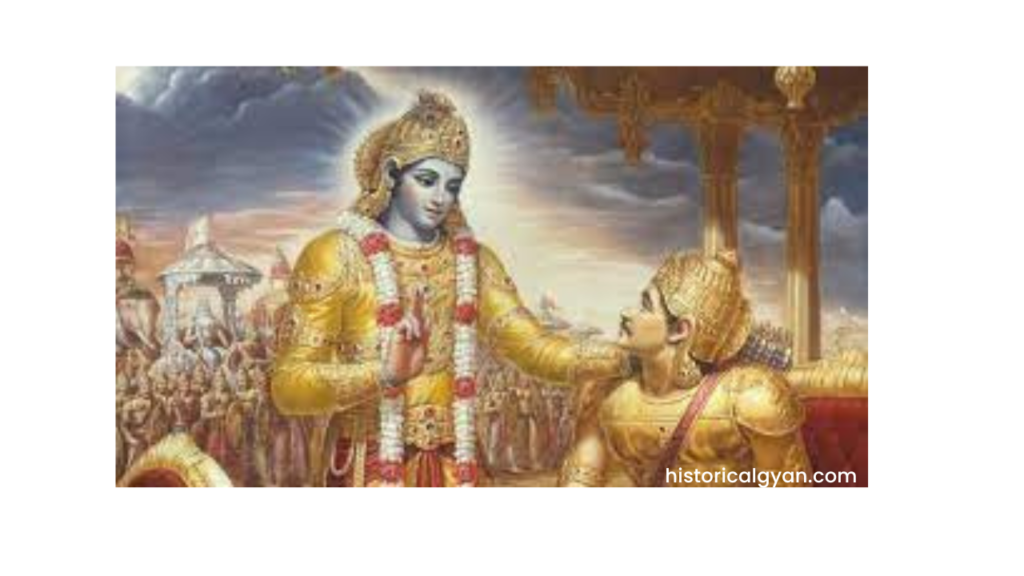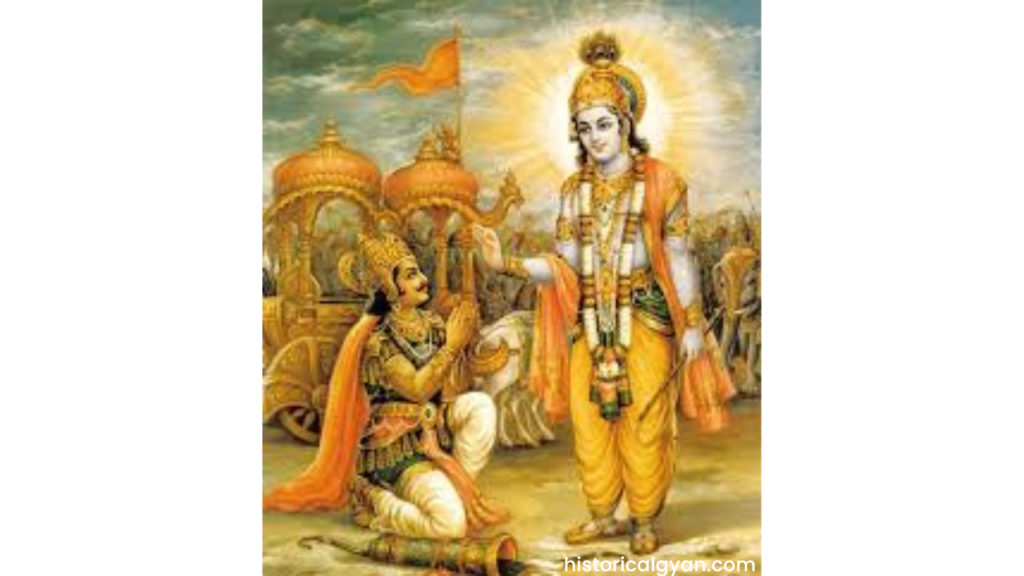Exploring the Universal Appeal of Bhakti Yoga
From the vibrant streets of India to the tranquil monasteries nestled within the Himalayas, and extending to contemporary spiritual gatherings spanning the globe, the magnetic appeal of Bhakti Yoga remains unmistakable. Yet, an intriguing query arises: why does the notion of Bhakti, expounded within Bhakti Yoga in Bhagavad Gita Chapter 12, resonate so universally?

Its teachings appear to resonate with sentiments discovered in disparate corners of the world, across varying cultures and religious observances. While spiritual practices in Christianity, Buddhism, and Taoism are frequently discussed, the connection they share with Bhakti Yoga piques our curiosity.
Are there intertwining threads of wisdom that bind these diverse traditions? Can the profound teachings of Bhakti Yoga offer illuminating perspectives not just for those well-versed in the Gita’s verses, but also for individuals hailing from an array of spiritual backgrounds? These inquiries serve as the crux of our quest as we set forth on a voyage to reveal the timeless enchantment intrinsic to Bhakti Yoga
Understanding Bhakti Yoga in Bhagavad Gita Chapter 12
Recognizing True Devotion: The Heart’s Genuine Calling

The diversity in devotion is reminiscent of a beautiful line from the Bible in Romans 12:6: “We have different gifts according to the grace given to each of us.” Just as every individual has a unique gift, every practitioner has their personal expression of devotion—each valid and profound. Recognizing and fostering genuine devotion goes beyond mere external acts of worship. It involves internal alignment, the heart’s genuine calling, and the soul’s thirst for connection.
Krishna provides clarity in the Gita by elaborating on the characteristics of a true devotee. One memorable excerpt describes those who “worship with the mind fixed on me, who are ever devoted and find delight in knowing me, are dearest to me.” Beyond external actions, true devotion resides in the heart’s alignment, the mind’s focus, and the soul’s delight in the divine connection.
Applying Bhakti Yoga in the Modern Context
In the midst of navigating today’s tumultuous world, the teachings of Bhakti Yoga emerge as a beacon of solace, a compass of guidance, and a path that leads us forward. The integration of devotion into the tapestry of daily existence can encompass practices such as meditation, the rhythmic chanting of sacred mantras, or engaging in selfless acts of service.
These seemingly simple actions, when permeated with unwavering devotion, metamorphose into profound transformative experiences, drawing the practitioner ever closer to the divine with each mindful breath.
Certainly, challenges will inevitably surface—distractions vying for our attention, doubts casting shadows on our resolve, and the weight of external pressures. Yet, the rich annals of Bhakti Yoga’s history stand as a resolute testament to its enduring potency. Across time, numerous souls have treaded this path, confronting adversities head-on and emerging from the crucible even stronger than before. Through the crucible of trials, their faith remains unswayed, and their devotion remains as brilliant as ever.
Embracing Divine Qualities: A Journey Within

Chapter 12 of the Bhagavad-Gita invites us to cultivate qualities that lead to spiritual elevation. These divine qualities shape our relationship with the universe, others, and most crucially, ourselves. Krishna’s guidance lays down a clear framework for personal growth.
Those who are free from malice toward others, who are friendly and compassionate, are dear to him. This isn’t merely a list of virtues but a consciousness that recognizes the inherent divinity in all.
Cultivating these qualities impacts daily life profoundly. The transformative power of love, compassion, and understanding is emphasized across spiritual traditions. This transformative journey demands resilience, perseverance, and a genuine desire for self-improvement. As one aligns with these divine qualities, life takes on a richer hue, and challenges become opportunities for growth.
Embracing Humility and Transcending Ego
In a world that celebrates assertiveness and self-promotion, the teachings of Chapter 12 offer a refreshing perspective. Humility and the transcendence of ego stand as central tenets, promising a path to genuine fulfillment and inner peace. Transcending the ego isn’t about diminishing oneself but recognizing a self that is untouched by the fleeting nature of worldly experiences.
Practically embracing humility involves daily choices—opting for understanding over judgment, service over self-interest, and compassion over critique. As the shackles of ego loosen, a liberated, expansive, and deeply connected self emerges.
The Universality of Devotion: A Confluence of Spiritual Streams
Chapter 12 from the Bhagavad-Gita portrays Bhakti Yoga, but this path isn’t confined to one tradition. Diverse cultures and religions echo the Gita’s sentiments, proving that the quest for divine connection is universal. The Gita’s emphasis on unwavering devotion finds resonance in teachings from Christianity, Islam, and other traditions. Devotion transcends boundaries, inviting souls from diverse backgrounds to journey toward the same luminous destination.
As we unravel aligned teachings from various traditions, it becomes evident that practices might differ, but the heart’s yearning remains strikingly similar. Devotion speaks to the core of human experience across epochs and cultures. This shared understanding of devotion forms a bridge between traditions, illuminating the profound mysteries of the heart.
Conclusion: Embarking on a Profound Journey of Self-Discovery

As we conclude this profound journey through Bhakti Yoga in Bhagavad Gita Chapter 12, we realize that devotion is a thread woven through the fabric of humanity’s spiritual journey. It’s a universal language that transcends cultural boundaries, echoing across traditions and time. The teachings of this chapter resonate with seekers, whether on bustling streets or serene monasteries.
In our exploration, we’ve delved into the essence of Bhakti Yoga, understood its connection to diverse traditions, and recognized its transformative power. We’ve explored humility’s role in transcending ego, finding genuine fulfillment in the process. As the universal quest for divine connection continues, we journey forward with shared insights, fostering deeper connections with the Divine and each other.
Frequently Asked Questions
1. What is the 12th chapter of Bhagavad Gita?
The 12th chapter of the Bhagavad Gita is known as “Bhakti Yoga” or the “Yoga of Devotion.” In this chapter, Lord Krishna imparts teachings about the significance of devotion and love in one’s spiritual journey.
2. What is the Bhagavad Gita Journey Chapter 12 verse 12?
In Bhagavad Gita Chapter 12, verse 12, Lord Krishna describes the qualities of a devotee who is dear to Him. The verse states: “The devotee who is free from malice toward others, friendly and compassionate, free from possessiveness and ego, content in both success and failure, forgiving, and endowed with determination and self-control, such a devotee is dear to Me.”
3. What is the Bhagavad Gita Chapter 12 verse 7?
In Bhagavad Gita Chapter 12, verse 7, Lord Krishna speaks about the supreme path of devotion. The verse reads: “And yet, those who fix their minds on Me and worship Me with unfailing devotion, I consider them to be the most integrated in Yoga.”
4. What is the 12th chapter of Bhagavad Gita?
The 12th chapter of the Bhagavad Gita is titled “Bhakti Yoga” or the “Yoga of Devotion.” It is a pivotal chapter that emphasizes the path of devotion, surrender, and love as a means to attain union with the divine. In this chapter, Lord Krishna elaborates on the qualities of a true devotee and describes various paths of devotion that lead to spiritual growth.
5. What exactly is Bhakti Yoga?
Bhakti Yoga is a spiritual pathway rooted in devotion, love, and surrender to the divine. It’s one of the primary paths of Yoga described in the Bhagavad Gita, concentrating on building a heartfelt connection with the divine through various acts and expressions of devotion.
6. How does Bhakti Yoga find resonance across different cultures?
Bhakti Yoga’s emphasis on love, devotion, and connecting with the divine speaks to the core of the human experience. These emotions are universal and are present in various cultures and spiritual traditions, transcending geographical and religious boundaries.
7. What sets Bhakti Yoga apart from other Yoga paths?
Unlike other paths of Yoga that might prioritize meditation, knowledge, or self-discipline, Bhakti Yoga centers on nurturing a profound emotional bond with the divine. It highlights surrendering the ego and merging with the divine through acts of love, service, and devotion.
8. Can individuals from diverse religious backgrounds practice Bhakti Yoga?
Absolutely. The essence of Bhakti Yoga, which is fostering a heartfelt connection with the divine, is a universal concept found in many religions. People from different faiths can incorporate Bhakti Yoga into their own spiritual practices.
9. How does Bhakti Yoga influence personal growth?
Bhakti Yoga encourages virtues like compassion, love, humility, and selflessness. Developing these qualities leads to personal growth, improved relationships, and a deeper understanding of oneself and others.
10. What role does humility play in Bhakti Yoga?
Humility is central to Bhakti Yoga as it involves transcending the ego and recognizing the divine in all beings. Practicing humility fosters a stronger sense of interconnectedness and genuine contentment.
11. Are there different approaches to practicing Bhakti Yoga?
Absolutely, Bhakti Yoga can be practiced through various methods such as prayer, meditation, chanting of mantras, singing devotional songs, engaging in selfless service (seva), and nurturing a loving attitude in day-to-day interactions.
12. How can Bhakti Yoga be applied in modern life?
Amidst the demands of modern life, Bhakti Yoga can be integrated by incorporating simple acts of love, kindness, and mindfulness. Participating in practices like meditation, devotional singing, and acts of service can help maintain a sense of connection with the divine.
13. How does Bhakti Yoga promote understanding among diverse spiritual traditions?
Bhakti Yoga’s focus on love and devotion creates a bridge between different traditions. By recognizing the shared pursuit of divine connection, individuals from various backgrounds can find common ground and mutual understanding.
14. Is Bhakti Yoga suitable for everyone?
Absolutely, Bhakti Yoga is inclusive for people of all ages, backgrounds, and physical abilities. It doesn’t demand advanced physical skills but rather a sincere heart and willingness to nurture a loving connection with the divine.
15. How can one initiate their practice of Bhakti Yoga?
Commencing with simple acts of love, gratitude, and mindfulness is a great entry point into Bhakti Yoga. Engaging in devotional practices like chanting, prayer, or meditation can gradually deepen your connection over time.
16. Is adherence to a specific religious belief necessary for practicing Bhakti Yoga?
Not necessarily, Bhakti Yoga transcends religious confines. While its origins lie in Hindu philosophy, its core principles of love and devotion are universal and can be embraced by individuals with various beliefs.
17. Can Bhakti Yoga assist in managing stress and anxiety?
Certainly, Bhakti Yoga practices can offer inner peace and tranquility, aiding in reducing stress and anxiety. Surrendering to a higher power and cultivating love and faith can provide solace during challenging times.
18. Can Bhakti Yoga lead to self-discovery or enlightenment?
Indeed, Bhakti Yoga is considered a pathway to self-discovery and spiritual enlightenment. By nurturing deep love and devotion, practitioners can experience a profound connection with the divine, resulting in heightened self-awareness and insight.
19. Where can I learn more about Bhakti Yoga and its practices?
Numerous resources are available, including books, online courses, and local spiritual communities dedicated to Bhakti Yoga. Exploring these resources can facilitate a deeper understanding and engagement with Bhakti Yoga.

